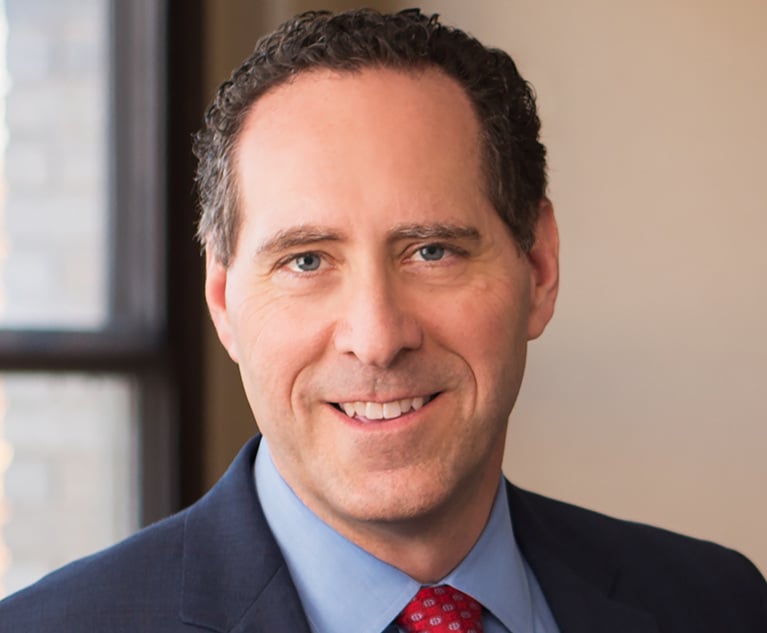Perfecting Your Elevator Pitch: Tips for Lawyers on the Rise
"What do you do?" This is a simple question, but it is one that is often misunderstood by young lawyers. There is an uncanny impulse to blurt out with pride, "I am a lawyer!" But what does that response really convey other than the fact that a person spent three years at law school and passed the bar exam?
February 05, 2020 at 01:03 PM
5 minute read
 Zachary Kimmel of Clark Hill.
Zachary Kimmel of Clark Hill.
"What do you do?" This is a simple question, but it is one that is often misunderstood by young lawyers. There is an uncanny impulse to blurt out with pride, "I am a lawyer!" But what does that response really convey other than the fact that a person spent three years at law school and passed the bar exam?
In reality, when asked, "What do you do?", it is not an inquiry about your profession. It is important to understand the subtext of the question, "What tangible value can you produce for me?" or more simply, "What value can you create for me?" The truth is, being a lawyer by trade does not create value. A lawyer's value is generated and measured by how the lawyer solves problems for his clients.
As these conversations will happen at every event a young lawyer will attend, whether it be social or professional, it is important to have an answer in the toolkit; one must be able to convey his value in an easily digestible manner or construct; this is commonly called an elevator pitch.
The most important thing to keep in mind when constructing an elevator pitch is the understanding that it is a fluid process. As lawyers travel through their careers, the ways problems are solved and value inevitably changes. As a result, the elevator pitch constructed as a first-year associate will not be the same elevator pitch deployed as a second- or third-year associate.
An effective elevator pitch should generally consider a simple strategy.
Audience
Who is this pitch meant for? Identifying a target audience is critical in clearly communicating value. Is the pitch meant to be heard by friends and family over holiday dinner, or is it something that will be delivered during a networking event with lawyers and other professionals? The former likely requires a less formal framing, while the latter assumes a higher level of sophistication and industry knowledge. Below are two examples of defense-side employment lawyer pitches that express the same value, yet do so using very different language.
- I work with companies to make sure they follow the law in handling employee-related issues like hiring, firing and overtime pay.
- My practice focuses on partnering with both private and public entities in ensuring consistent compliance under Title VII with respect to employment practices.
The first example, which is the less formal scenario, concisely states the client and provides concrete examples of the types of problems solved. This type of elevator pitch lends itself to an audience who may not be familiar with the kinds of issues employment lawyers routinely face and the types of clients requiring this service. The second example is more detailed, as it more fully addresses the scope of clients served and provides a specific type of reoccurring problem that the lawyer solves.
Framing Value
In some circumstances, you may be aware of something in the news, recent legislation or otherwise that has the potential to directly affect a specific grouping of people. For example, newly adopted legislation may require an employer to add new information to employee pay stubs. In this situation, it would be beneficial to tweak the elevator pitch to address this change and reflect value accordingly as demonstrated in the example below.
- My practice, in part, focuses on partnering with employers to ensure contemporaneous compliance with newly passed regulations like the updated Pennsylvania wage statement law.
This pitch, while providing value generally, goes one step further and directly engages the individual by moving their potential problem, whether that problem is known or not to the client, and the solution to center stage. A young lawyer should utilize a pitch like this for networking events that cater to a single industry where the participants share a common problem.
Practice
Once the basic formula of the elevator pitch is constructed, the only way to perfect delivery is to rehearse it out loud. A young lawyer must become comfortable talking about their value with the same familiarity as when talking about the weather. A best practice to ensure that an elevator pitch translates is to rehearse the pitch in a mirror, even if it can be a bit of an awkward exercise. It allows total awareness, including hearing how the pitch sounds off paper and taking note of body language. Questions to ask while practicing include:
- Pace: Am I speaking too quickly?
- Clarity: Am I enunciating each word?
- Body language: Are my hands at my side?
After an honest self-critique and repetition, the delivery should feel natural and therefore will impart confidence in the listener, as the value from the pitch has translated. Finally, before taking the pitch out on the road, rehearse it live with senior attorneys and partners who will give honest feedback. Choose colleagues in the same or similar practice group who are familiar with the work and expertise you are trying to gain, and who know your personal strengths.
Constructing, altering, perfecting and rehearsing an elevator pitch is one of the most important tasks a young lawyer undertakes so they are able to quantify their value early on in their career. If the steps are taken early and correctly, a young lawyer will never need to only respond, "I am a lawyer!" when asked the inevitable question, "What do you do?"
Zachary M. Kimmel is an associate with the labor and employment practice group in Clark Hill's Philadelphia office. He partners with both private and public sector employers in handling disputes, ensuring statutory compliance and consulting with clients on best practices in the workplace.
This content has been archived. It is available through our partners, LexisNexis® and Bloomberg Law.
To view this content, please continue to their sites.
Not a Lexis Subscriber?
Subscribe Now
Not a Bloomberg Law Subscriber?
Subscribe Now
NOT FOR REPRINT
© 2025 ALM Global, LLC, All Rights Reserved. Request academic re-use from www.copyright.com. All other uses, submit a request to [email protected]. For more information visit Asset & Logo Licensing.
You Might Like
View All
Superior Court Directs Western Pa. Judge to Recuse From Case Over Business Ties to Defendant
3 minute read
Neighboring States Have Either Passed or Proposed Climate Superfund Laws—Is Pennsylvania Next?
7 minute read
Cohen Seglias Leader Discusses Growing From Construction Practice into Full-Service Law Firm
Law Firms Mentioned
Trending Stories
- 1Settlement Allows Spouses of U.S. Citizens to Reopen Removal Proceedings
- 2CFPB Resolves Flurry of Enforcement Actions in Biden's Final Week
- 3Judge Orders SoCal Edison to Preserve Evidence Relating to Los Angeles Wildfires
- 4Legal Community Luminaries Honored at New York State Bar Association’s Annual Meeting
- 5The Week in Data Jan. 21: A Look at Legal Industry Trends by the Numbers
Who Got The Work
J. Brugh Lower of Gibbons has entered an appearance for industrial equipment supplier Devco Corporation in a pending trademark infringement lawsuit. The suit, accusing the defendant of selling knock-off Graco products, was filed Dec. 18 in New Jersey District Court by Rivkin Radler on behalf of Graco Inc. and Graco Minnesota. The case, assigned to U.S. District Judge Zahid N. Quraishi, is 3:24-cv-11294, Graco Inc. et al v. Devco Corporation.
Who Got The Work
Rebecca Maller-Stein and Kent A. Yalowitz of Arnold & Porter Kaye Scholer have entered their appearances for Hanaco Venture Capital and its executives, Lior Prosor and David Frankel, in a pending securities lawsuit. The action, filed on Dec. 24 in New York Southern District Court by Zell, Aron & Co. on behalf of Goldeneye Advisors, accuses the defendants of negligently and fraudulently managing the plaintiff's $1 million investment. The case, assigned to U.S. District Judge Vernon S. Broderick, is 1:24-cv-09918, Goldeneye Advisors, LLC v. Hanaco Venture Capital, Ltd. et al.
Who Got The Work
Attorneys from A&O Shearman has stepped in as defense counsel for Toronto-Dominion Bank and other defendants in a pending securities class action. The suit, filed Dec. 11 in New York Southern District Court by Bleichmar Fonti & Auld, accuses the defendants of concealing the bank's 'pervasive' deficiencies in regards to its compliance with the Bank Secrecy Act and the quality of its anti-money laundering controls. The case, assigned to U.S. District Judge Arun Subramanian, is 1:24-cv-09445, Gonzalez v. The Toronto-Dominion Bank et al.
Who Got The Work
Crown Castle International, a Pennsylvania company providing shared communications infrastructure, has turned to Luke D. Wolf of Gordon Rees Scully Mansukhani to fend off a pending breach-of-contract lawsuit. The court action, filed Nov. 25 in Michigan Eastern District Court by Hooper Hathaway PC on behalf of The Town Residences LLC, accuses Crown Castle of failing to transfer approximately $30,000 in utility payments from T-Mobile in breach of a roof-top lease and assignment agreement. The case, assigned to U.S. District Judge Susan K. Declercq, is 2:24-cv-13131, The Town Residences LLC v. T-Mobile US, Inc. et al.
Who Got The Work
Wilfred P. Coronato and Daniel M. Schwartz of McCarter & English have stepped in as defense counsel to Electrolux Home Products Inc. in a pending product liability lawsuit. The court action, filed Nov. 26 in New York Eastern District Court by Poulos Lopiccolo PC and Nagel Rice LLP on behalf of David Stern, alleges that the defendant's refrigerators’ drawers and shelving repeatedly break and fall apart within months after purchase. The case, assigned to U.S. District Judge Joan M. Azrack, is 2:24-cv-08204, Stern v. Electrolux Home Products, Inc.
Featured Firms
Law Offices of Gary Martin Hays & Associates, P.C.
(470) 294-1674
Law Offices of Mark E. Salomone
(857) 444-6468
Smith & Hassler
(713) 739-1250






